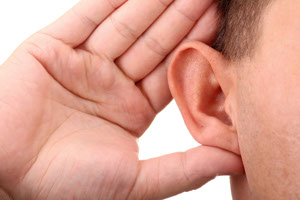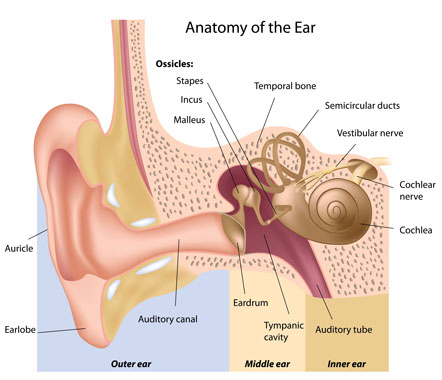Welcome to the Audiology Center at New England ENT and Facial Plastic Surgery
Hearing Loss

You may have hearing loss, and not even be aware of it. People of all ages experience gradual hearing loss, often due to the natural aging process or long exposure to loud noise. Other causes of hearing loss include viruses or bacteria, heart conditions or stroke, head injuries, tumors, and certain medications. Treatment for hearing loss will depend on your diagnosis.
Hearing is a complex and intricate process. The ear is made up of three sections: the outer ear, the middle ear, and the inner ear. These parts work together so you can hear and process sounds. The outer ear, or pinna (the part you can see), picks up sound waves and directs them into the outer ear canal.
These sound waves travel down the ear canal and hit the eardrum, which causes the eardrum to vibrate. When the eardrum vibrates, it moves three tiny bones in your middle ear. The middle ear is a small air-filled space between the eardrum and the inner ear. These bones form a chain and are called the hammer (or malleus),
anvil (or incus), and stirrup (or stapes). The vibration of these bones transmits and amplifies the sound waves toward the inner ear. The third bone in the chain, the stapes, interfaces with fluid in the cochlea (the hearing portion of the inner ear). The cochlea is lined with cells that have thousands of tiny hairs on their surfaces. As the fluid wave travels through the cochlea, it causes the tiny hairs to move. The hairs change the mechanical wave into nerve signals. The nerve signals are then transmitted to your brain, which interprets the sound.
Evaluation
The providers at the New England ENT are fully qualified to evaluate and manage hearing loss in all age groups. A screening test from a hearing aid dealer may not be adequate. We have fully trained audiologists in our offices to assess your ability to hear pure tone sounds and to understand words. The results of these tests will indicate the degree and type of hearing loss.


Hearing Aids
Over 30 million Americans have hearing loss and 50 Million Americans experience tinnitus, or ringing in the ears. Our highly educated and experienced clinical audiologists diagnose hearing loss and provide aural rehabilitation through the use of hearing aids and tinnitus maskers.
How much do hearing aids cost?
Hearing aids vary in price from $1000 to $3200 based on level of technology and available features (tinnitus maskers, blue tooth connectivity, etc). The hearing aid companies that our audiologists work with provide reputable products and excellent customer service. Product reliability can save on repair costs and decrease frustration of a malfunctioning hearing aid.
What are the different styles?
- Behind-the-ear (BTE) aids go over the ear and are connected with tubing to a custom-fit ear mold.
- Receiver-in-the-ear (RITE) aids are a newer design, and while still placed over the ear they are extremely sleek and nearly invisible. Also, the part of the hearing aid that sits in the ear is smaller and less occluding than a traditional ear mold.
- In-the-ear (ITE) aids fill the entire bowl of the ear and part of the ear canal. This is a good option for people with poor dexterity because they are large and fairly easy to insert.
- In-the-canal (ITC) and Completely-in-the-canal (CIC) aids are smaller versions of the ITE, but still block the entire ear canal.
The best hearing aid style for you depends on:
- degree of hearing loss
- listening needs
- size and shape of your ear
- fine motor skills

Our audiologists will assist in finding the best style and technology to meet your needs and budget.
Will I need a hearing aid for each ear?
This depends on your hearing loss. If you have hearing loss in both ears it is best to wear two hearing aids to help with sound localization. Also, the newer technology has binaural processing and coordination, meaning the hearing aids work together to help you hear better in a noisy environment.
What will happen at my hearing aid fitting?
The audiologist will ensure the hearing aids fit comfortably in your ear. She will then digitally program the hearing aids and make any needed programming adjustments so they sound comfortable. Next, you will receive instruction about how to use and take care of the hearing aids.
Is that the only time I will meet with the Audiologist?
The audiologist is available to meet with you continually to make sure the hearing aids are comfortable. It is common to meet with the audiologist two or three times in the first month to make sure everything is going well.
